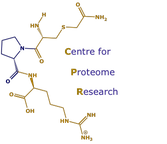services
Can you measure the mass of my protein?
14/05/15 09:41 Filed in: Services
In short, probably yes!
We have set up a semiautomated system for the mass measurement of intact proteins, coupled to a very high quality instrument (Synapt G2si). This system will measure the mass of a protein to about 1Da in 10,000Da, and requires only microgram quantities of protein. The mass is measured by electrospray ionisation mass spectrometry and thus, the protein molecule acquires a large and variable number of charges (protons). Each protein thus creates a multiply-charged envelope of ions that need to be deconvoluted by proprietary software using maximum entropy algorithms. The result is a true mass spectrum that can reveal the mass of the analyte protein and also, the mass of associated contaminants and possibly, fragments or modifications.
We have set up a semiautomated system for the mass measurement of intact proteins, coupled to a very high quality instrument (Synapt G2si). This system will measure the mass of a protein to about 1Da in 10,000Da, and requires only microgram quantities of protein. The mass is measured by electrospray ionisation mass spectrometry and thus, the protein molecule acquires a large and variable number of charges (protons). Each protein thus creates a multiply-charged envelope of ions that need to be deconvoluted by proprietary software using maximum entropy algorithms. The result is a true mass spectrum that can reveal the mass of the analyte protein and also, the mass of associated contaminants and possibly, fragments or modifications.
Proteomics as a service
How can I have proteomics samples run?
We are always willing to talk to colleagues about the potential for running new analyses. These can vary from simple 'quick look' analyses to complete and complex, fully biologically replicated analyses. In all circumstances, we adopt a model of 'defend the mass spectrometer form the sample'! In fact, mass spectrometers are remarkably robust; it is the delivery of peptides through a nanoflow high pressure chromatography system that causes the problems.
Biological samples can be delivered in exotic and complex matrixes, either reflecting the biological context of the sample or the sample work up chemistry imposed by the user m(detergent, PEG and glycerol might seem like a dream extraction buffer to you, but we are never going to run that sample for you!). We are very reluctant to receive samples that contain insoluble material, high concentrations of detergents, polymers such a polyethylene glycol (PEG), for example. A nanoflow high resolution column (75um diameter and 150mm long) costs, with trap, nearly £1,000 and is time consuming to exchange and optimise. You can see why we're reluctant to take anonymous samples!
It is far, far better if you come to talk to us before you attempt to prepare proteomics samples.
We are always willing to talk to colleagues about the potential for running new analyses. These can vary from simple 'quick look' analyses to complete and complex, fully biologically replicated analyses. In all circumstances, we adopt a model of 'defend the mass spectrometer form the sample'! In fact, mass spectrometers are remarkably robust; it is the delivery of peptides through a nanoflow high pressure chromatography system that causes the problems.
Biological samples can be delivered in exotic and complex matrixes, either reflecting the biological context of the sample or the sample work up chemistry imposed by the user m(detergent, PEG and glycerol might seem like a dream extraction buffer to you, but we are never going to run that sample for you!). We are very reluctant to receive samples that contain insoluble material, high concentrations of detergents, polymers such a polyethylene glycol (PEG), for example. A nanoflow high resolution column (75um diameter and 150mm long) costs, with trap, nearly £1,000 and is time consuming to exchange and optimise. You can see why we're reluctant to take anonymous samples!
It is far, far better if you come to talk to us before you attempt to prepare proteomics samples.
Who are CPR?
We are the Centre for Proteome Research, located on the ground floor of the Biosciences Building. The group is led by Claire Eyers and Edward Emmott, both of whom have independent, research programmes. In addition, we are the Proteomics Shared Research facility (SRF) that is part of the Technology Directorate at the University. This means that we can also conduct proteomics experiments for colleagues in the Faculty, and beyond..
